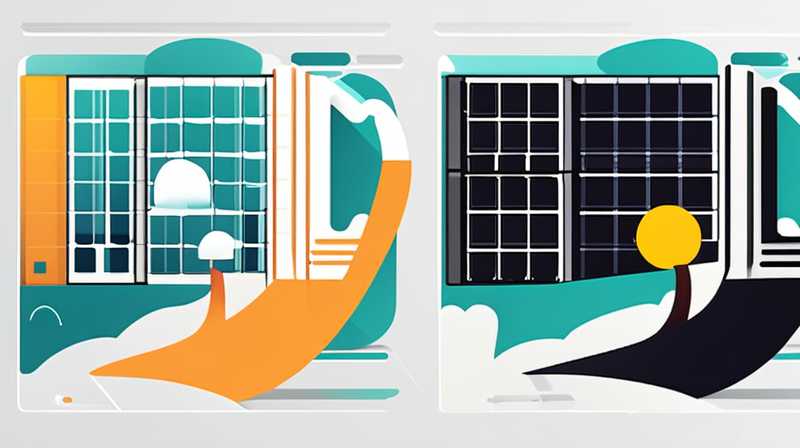
1. IMMEDIATE STEPS TO TAKE: If solar power generation fails, 1. check the inverter and solar panel connections, 2. inspect for shading or debris, 3. monitor battery charge levels, 4. utilize backup power sources. If the inverter’s error codes indicate issues, refer to the manufacturer’s manual for specific troubleshooting. In-depth examination of connections and components may reveal faults or necessary adjustments that can restore functionality, hence preserving energy efficiency.
2. UNDERSTANDING SOLAR SYSTEM FUNCTIONALITY: Solar energy systems operate through photovoltaic cells that convert sunlight into electricity. This technology relies on inverters to convert direct current (DC) produced by solar panels into alternating current (AC), which is utilized by home appliances. Various factors can disrupt this delicate balance, leading to power shortages.
3. TROUBLESHOOTING SOLAR POWER ISSUES: When electricity generation ceases unexpectedly, begin by assessing the inverter. It often serves as a diagnostic tool, offering error codes that indicate specific problems. Ensure that the unit is powered on, as a simple power interruption can occasionally be the culprit. If the inverter shows signs of overload or malfunction, resetting it can sometimes restore normal function.
4. PHYSICAL INSPECTION OF SOLAR PANELS: A thorough examination of solar panels is crucial. Dust, debris, or even snow accumulation can obstruct sunlight, significantly reducing output. Check the panels regularly for any physical damage, such as cracks or scratches, which might impede performance. The orientation and angle of the solar array must also align with the sun’s path to maximize efficiency.
5. MONITORING BATTERY CHARGE LEVELS: If the solar system incorporates a battery storage solution, monitoring its charge is essential. Different battery technologies—such as lithium-ion, lead-acid, or flow batteries—each possess unique characteristics and requirements. A drained battery could lead to a complete power outage. Understanding the specific charge thresholds and maintenance practices for your battery type can ensure longevity and reliability.
6. ALTERNATIVE POWER SOURCES: In the event of a prolonged disruption in solar power, identifying alternative power sources is vital. Generators, whether diesel, gasoline, or propane-powered, can provide temporary relief during extended outages. However, it is essential to consider the environmental impact and operational costs associated. Hybrid systems, which incorporate both solar and conventional energy sources, may offer greater resilience in such situations.
7. CONNECTIONS TO THE GRID: If your solar power system is grid-tied, understand how utility companies manage outages. Some utilities offer net metering, allowing homeowners to draw from the grid during shortages while still earning credits for excess energy produced during sunny days. Familiarizing oneself with local regulations and policies surrounding grid connections can help maximize the benefits of this synergy.
8. REGULAR MAINTENANCE PRACTICES: Integrating routine maintenance practices can prevent many common issues. Periodic professional inspections should be part of your solar system’s upkeep to ensure everything functions optimally. Both physical sanitation and electrical checks, such as examining wiring and circuit integrity, will enhance the solar system’s overall efficiency.
9. CUSTOMER SERVICE AND SUPPORT: When problems arise that cannot be resolved through DIY troubleshooting, contacting customer service or a professional technician is the next prudent step. Professionals can provide deeper insights into advanced issues that might not be evident to the average user. Always maintain a record of interactions and service requests for smoother troubleshooting in the future.
10. LEARNING FROM FAILURE: Finally, develop a proactive approach to mitigate future issues by understanding the failure points in your solar power generation system. Conducting research and attending workshops can enhance your knowledge regarding maintenance and troubleshooting. Also, consider joining online communities or forums where solar energy enthusiasts share experiences, advice, and solutions to common challenges.
FAQs
1. WHAT CAN I DO IF MY SOLAR POWER SYSTEM STOPS WORKING?
In the event of a breakdown in solar power generation, first, check the inverter for error codes and ensure all connections are secure. Next, inspect the solar panels for dirt or debris that might inhibit performance. You may also want to verify that your battery levels are adequate if your system utilizes a battery storage solution. If these steps do not resolve the issue, it may be time to seek professional assistance to diagnose and address any underlying problems.
2. HOW OFTEN SHOULD I MAINTAIN MY SOLAR ENERGY SYSTEM?
Routine maintenance is key to ensuring an efficient solar energy system. It is advisable to conduct a thorough inspection and cleaning at least twice a year. However, in regions prone to dust, snow, or other environmental factors, more frequent checks may be necessary. Enlisting professional assistance annually can also help spot underlying issues that may affect the functionality of your solar panels and associated components, ultimately enhancing the system’s lifespan and efficiency.
3. IS IT WORTH INSTALLING A BACKUP POWER SYSTEM?
Installing a backup power system can provide significant peace of mind. In cases where solar energy generation is interrupted, having alternative power sources, such as generators or battery units, ensures continuous access to electricity. The decision ultimately depends on individual circumstances, such as the frequency of outages in your area and the importance of maintaining a constant power supply for your household or business functions.
BOLD WRAP-UP: Understanding the intricacies of solar power generation is essential for developing survival strategies during unexpected outages. By evaluating physical components like inverters and panels, monitoring battery storage levels, and being prepared with alternative power solutions, homeowners can mitigate the impacts of electricity loss typically associated with solar systems. Ensuring routine maintenance and being integrated with grid systems can further provide reassurance and stability. The proactive approach to diagnosing potential issues may lead to heightened efficiency. Utilizing available customer support can also navigate complexities and grant valuable insights into system upkeep. Ultimately, improved knowledge of the solar energy landscape not only enhances individual preparedness but promotes a sustainable transition to renewable energy solutions that benefit the greater community.
Original article by NenPower, If reposted, please credit the source: https://nenpower.com/blog/what-to-do-if-there-is-no-electricity-from-solar-power-generation/


